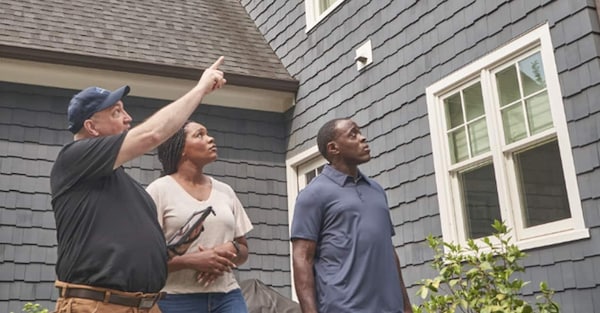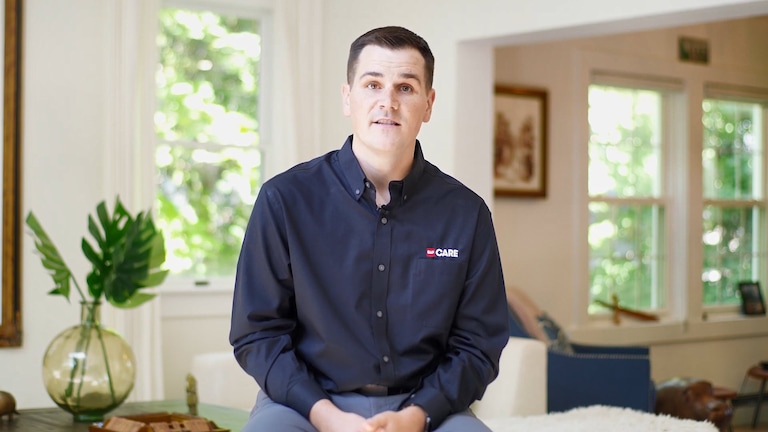
Navigating Roof Insurance Claims
Know when to contact your homeowners insurance company
Homeowners insurance policies typically cover damage that is sudden and accidental, from causes like fire and smoke; hail; wind; and the weight of snow, ice, or sleet.

Roof damage causes that may be covered by insurance
- Weather events like lightning, wind, or hail
- Debris including fallen trees
- Fire
- And more

What does a homeowners insurance policy cover?
A typical homeowners insurance policy provides coverage for three major types of damages:
- The structure of your house
- Your belongings
- Your personal liability for injury and property damage to others
Homeowner Insurance Basics
Watch the video seriesBest practices for filing a roof insurance claim
Be prompt
The longer it takes to repair your roof, the more likely it is to expose your home to further damage.
Document everything
Providing receipts, photos, a list, or a home inventory that confirms the value and description of roof and exterior damage will help the claims process run smoothly.
Make temporary repairs
Make sure that any openings or damage to the structure of your home won’t result in further damage. make temporary repairs and hold onto the receipts.
Prepare for the adjuster

Five steps to file a claim
Get instant access to the GAF video series "Navigating Roof Insurance Claims" and to learn more about products, services, programs, and promotions that may interest you.
What do insurance adjusters look for on roofs?
Your insurance adjuster will look for evidence that damage is recent or sudden, as opposed to standard wear and tear, and that the damage is covered by your policy. It can help to have an estimate in hand when meeting with the adjuster.

The right contractor may help with the insurance process
In some cases, it may be a good idea to have a roofing contractor meet the adjuster at your home to show what damage they have identified.
Tips for finding a roofer
Supplement an insurance payment to get the roof you want

Credit cards or financing
Using a credit card may be a good solution to short-term cash flow gaps. Not all contractors accept credit cards — ask if yours does. Financing may also be an attractive option especially if you are considering other home improvements such as siding or gutters. Today many contractors can offer simple online application and multiple loan options.
Watch the Understanding Your Insurance Policy video series
Video seriesDeductibles
The deductible is often a fixed dollar amount – usually $500 to $2,000, but it can be higher – or it may be a percentage of the home’s insured value. Typically, insurers will subtract your deductible from the settlement amount when they issue payment.
Out-of-pocket costs
With homeowners insurance, the deductible is one type of out-of-pocket cost each time you file a claim.
Open Peril vs Named Peril
The most common type of homeowners insurance is an HO-3 policy. HO-3 policies typically have open perils coverage on the structure of a house and named perils coverage for your personal property.
Lines of coverage
There are four common things covered under a typical homeowner’s policy: Dwelling, Separate or Other Structures, Personal Property, and Additional Living Expense or Loss of Use.
ACV vs Replacement Cost
Actual Cost Value — or ACV — is a measure of the value of insured property. Replacement cost is the actual cost to replace an item at its pre-loss condition, whereas ACV is calculated by subtracting an item’s depreciation from its replacement cost.
Insurance depreciation
Generally, depreciation is calculated by evaluating an item’s Replacement Cost Value (RCV) and its life expectancy. The condition of an item may also factor into the depreciation calculation.
Frequently Asked Questions
Roof damage is a condition caused by an external force, such as impact or severe weather, that is separate from wear and tear.
In cases where only a portion of the roof has been damaged, your insurance carrier will assess whether to cover cost to repair those sections, or to replace the entire roof.
Get a detailed estimate from a manufacturer-certified roofing contractor, and make sure it includes costs for tear-off (if necessary) all materials, labor, clean-up, and disposal.
Home insurance will typically cover roof leaks caused by sudden damage, but not leaks that have developed over time because of normal wear and tear or aging.
Getting a new roof can be easy when you know where to start. Follow these steps for making the experience a great one.
GAF resources to help contractors tackle the insurance restoration process
We offer resources to help contractors work with homeowners.
GAF QuickMeasure™
Get a GAF QuickMeasure™ report with accurate roof measurements and high-resolution imagery.
GAF QuickMeasure
GAF ScopeConnect℠
The service offers a complete insurance scope of work in an industry standard format.
GAF ScopeConnect
